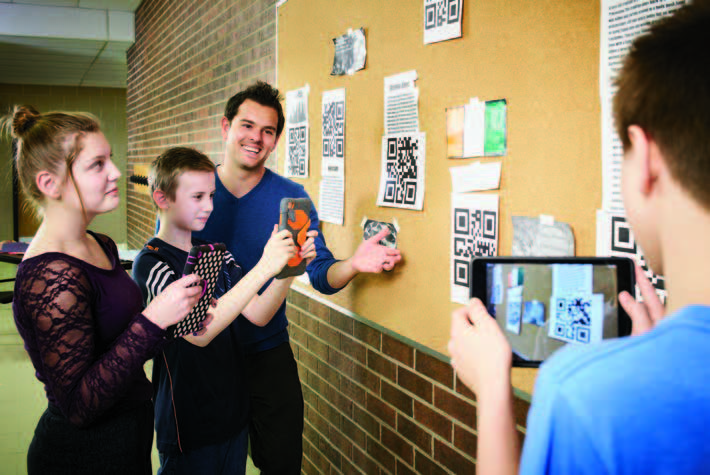Share this page
A Grade 7 and 8 math teacher converts an old-school cork surface into a 21st-century digital display.
By Stefan Dubowski
Photo: Matthew Liteplo

The Challenge: Make better use of traditional bulletin boards to engage students in the learning process.
The Solution: Have students find web examples to illustrate a lesson. Using free online software, create QR codes that link to those examples. Pin the codes to a bulletin board, where they can scan the codes with smartphones and tablets to see the links and learn from one another.
Lessons Learned: Imagine transforming a plain old bulletin board into a high-tech space where students can demonstrate creativity and resourcefulness. That’s what Brian Aspinall, OCT, did for his Grade 7 and 8 homeroom students. A teacher at Indian Creek Road Public School in Chatham, Aspinall used simple software, a printer and mobile devices to engage his class and display their work in a whole new way.
In addition to making better use of standard bulletin boards, Aspinall also wanted to reinforce skills that students need to master in this information age, like the ability to discern whether or not online information is credible. He brought it all together using mobile technology, a lesson in mathematical probability and QR code software.
He tasked his class with finding effective online examples of probability — such as videos of coin-flip experiments. Then he had the students use GoQR.me, free online software for creating QR codes linked to websites.
When you hold a mobile device up to a QR code, the image will direct the device to a particular website. In Aspinall’s class, students linked the codes to the sites they found. Then they printed the codes on paper and attached the images to the bulletin board, where they could scan them to see the websites their peers recommended.
Observations: Aspinall was pleased that students assessed the images, videos and stories they found online, deciding whether they were credible and useful before sharing them with classmates.
The students also benefited from the chance to discover resources that spoke to them. “For students who aren’t working at grade level, they may find an example that they understand rather than struggle with the textbook,” Aspinall says.
Some students took the concept into their personal lives. One young man convinced his father to use QR codes on his work trucks to promote his business, while another taped QR codes around the home to get the weather and sports scores. For those youngsters, the QR code exercise may have helped spark important skills such as entrepreneurial thinking and media literacy. Broadly speaking, the bulletin-board rejuvenation project provides a link between traditional education tools and new learning strategies.
The College’s professional advisory Use of Electronic Communication and Social Media (oct-oeeo.ca/1iqmDeO) guides members’ professional judgment in the use of technology.
Helpful Hint: Brian Aspinall, OCT, advises teachers to fearlessly try new technology for the first time, along with your students. “It’s a great way to model the process of problem-solving and risk-taking,” he says. “And it’s safe place to fail.”
What You’ll Need:
Steps to Take: